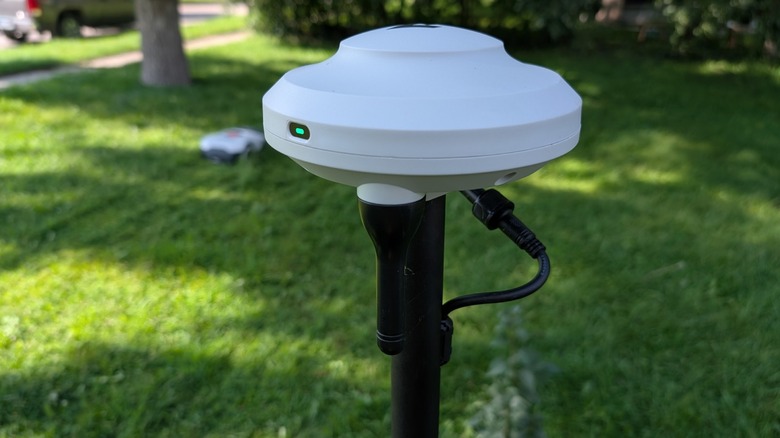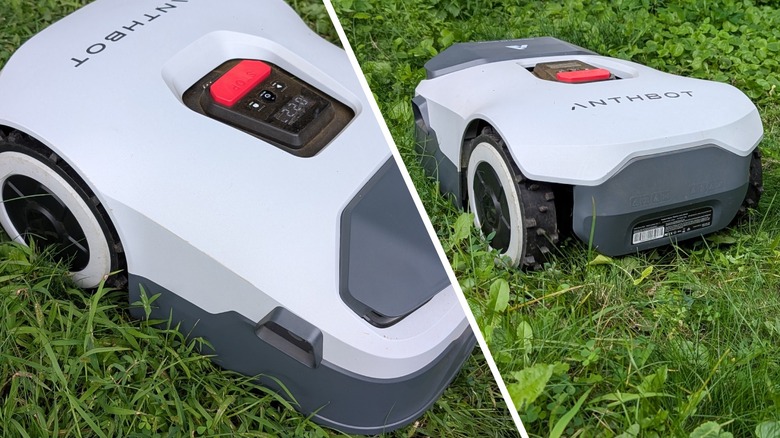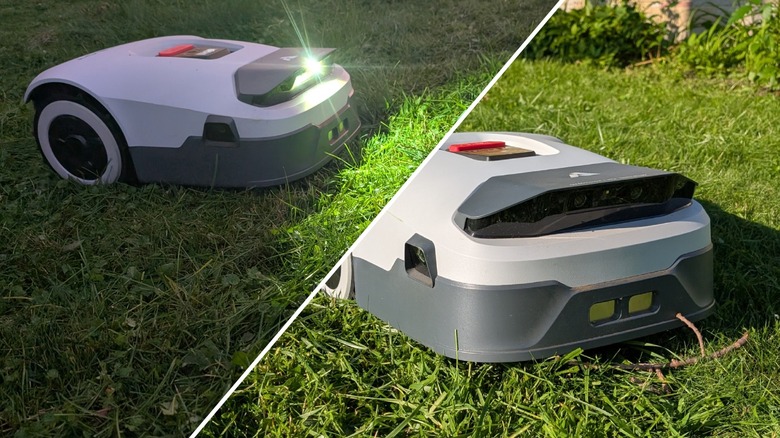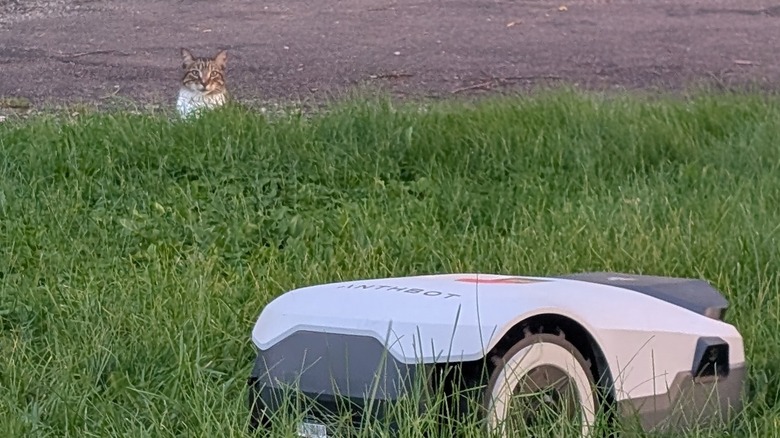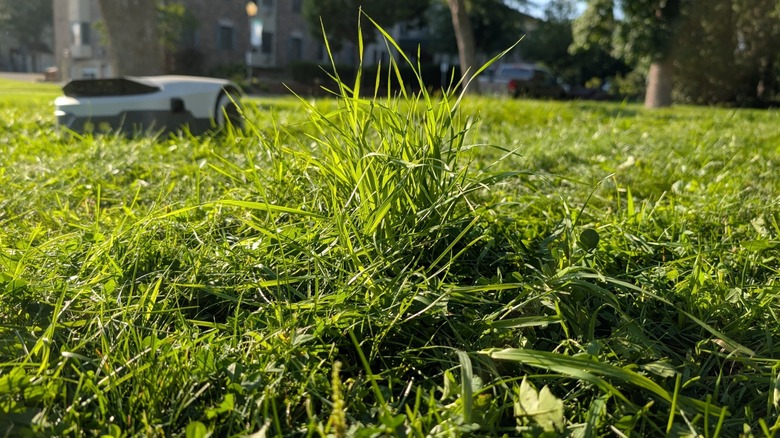Robot Mowers Are Finally Practical, And This One Is The Easiest Yet
The Anthbot Genie 3000 is a robotic lawn mower that took over all the hard parts of mowing my lawn. Or, at least, it did while I had it sent here from Anthbot for this review. In the past several weeks, I've become convinced that we're at that all-important tipping point when it comes to AI-assisted robot lawn mowing in general — it's easy now.
SlashGear's reviewed robotic mowers before — some significant changes have been made in the robot lawn mower market in the recent past — there are some important facts about robot lawn mowers most people probably do not know. For example — in the last half-decade, the whole first act has changed. Each time I've considered the value of any device like this, I've called out the immense learning curve, the prep time, the sacrifices that needed to be made in order to let any robot lawn mower trim a yard. In the past, it felt like more work than it was worth to get a robotic lawn mower (from any given brand) set up to work properly. That's no longer true.
In the time I've had the Anthbot Genie 3000 working on my yard, my perspective on lawn maintenance has changed drastically. This robot doesn't completely relieve me of the entirety of the work that needs to be done to keep my grass tidily trimmed — it's not quite that precise just yet — but it's close.
Setup Time
The most difficult part of getting the Anthbot Genie 3000 up and running was getting the robot out of the box. This robot is not a lightweight. But it doesn't require any assembly once it's out — the only assembly needed for this device is in its RTK reference station (the thing that looks like a UFO flying disk on a pole).
You'll need to find a place to plug a power plug in (a standard wall socket), connect that to the robot's charging dock, and you'll have to find a proper spot to plant the pole that holds the device's RTK reference station. RTK stands for real time kinematics — a system that utilizes and corrects location satellite data in order to tell the robot its location/position with extreme precision.
RTK tech has been in use for a while now — it's used in drones like the https://www.slashgear.com/dji-matrice-300-drone-offers-nearly-an-hour-of-flight-07619698/ DJI Matrice 300 RTK, you'll find it in autonomous snow blowers, you might remember seeing a self-driving Supra Drift Car from Toyota rolling with RTK-enabled location tracking inside, and it's been in use for a while for construction work and land surveying. RTK tech's been in use in commercial applications for well over 20 years (and work's been done on it and with it for far longer than that.)
But you needn't know any of that in order to get this robot going. Once the charging dock and the RTK reference station are set, the mapping of your yard can begin.
Mapping Before Mowing
You'll need to connect the mower to your phone with Bluetooth, and you'll need the Anthbot app to control the mower. Once you're properly connected, you'll have the option of allowing the mower to roll around and map your whole yard automatically. It's very smart — but my yard is strange and there are parts that I'm not confident any robot will know not to cross into without me driving manually — at first.
So I opted to map the whole yard manually — which is fun, because it requires that I pilot the Anthbot Genie 3000 from my phone like an RC race car toy. I drove this drone around my whole yard, bit by bit, and mapped out the various sections I have, interrupted by sidewalks and marked by no-go zones. This was easy.
If it'd been a pain, I'd absolutely tell you how painful it was — but it wasn't. The controls are simple, and the process is easy. I don't know if it'd be easy enough for absolutely anyone to understand right out the gate, but I truly had no issue in creating a simple map of my whole yard. Then I separated the yard by zones in the app so I can tell the robot to mow one spot first, then another, and with different directions for each zone.
Zones, Directions, Controls
I mapped the yard, then I made a set of square boxes in the mapping bit of the app — these are called "Zones." Each zone has granular controls I can work with to change the direction the lawn is cut as well as the height of the cut of the grass. You can also set mowing times (1x or 2x), and you can adjust your Visual Inspection level to Low, Medium, or High (highest is best if you absolutely want the robot to avoid anything that might not be grass).
You can also use the robot manually — you can drive it around with the mower on, if you feel the need. I tried it, and it is fun, but feels a bit redundant if I'm only using it to find places the mower might've missed or might've avoided (because it thinks a big patch of crab grass is actually something more nefarious or fragile). So I've been doing all the fine details with my weed whip while the robot does all the heavy work.
Also the robot has a headlight so it can see things at night, if the need should arise. A combination of that and the sensor system it employs allows it to work pretty much regardless of the lighting conditions that surround it.
Safety And Precision
I watched this mower very carefully. I tested its safety features as far as I was comfortable doing so. I put my bare foot in front of the mower — it did not run over my foot. I watched the mower running through my yard with the neighborhood cat alongside me — he was also curious. The robot has not come anywhere near the cat.
The closest I came to disaster with this robot was when I purposefully avoided telling it about a sudden drop-off area in my yard where a piece of land creates a 1-foot cliff over an empty flower bed. The robot does not appear to be able to account for the possibility that it might slip and fall down to its doom. This is where this robot differs from some of the best robot vacuums on the market today — there is no camera underneath the robot to see sudden plummets.
But the good news is — it immediately stopped. The robot stops on a dime. The moment the robot started to slip over the edge, it stopped mowing and it tried to recover. When it couldn't, it stopped moving entirely and awaited assistance.
Based on my experience with this robot, it's more likely that it'll stop moving entirely than it will cut anything it's not meant to cut. Multiple sensors and cameras allow this robot to cut what it needs to cut, avoid things it shouldn't cut, and avoid rain, too. The robot is waterproof (enough to survive rain and washing with a hose), but it has a moisture sensor that'll send it driving home whenever it detects rain — because wet grass makes for bad lawn mowing.
Wrap-Up: The Price Of Convenience
While reviewing this robot, I've seen my yard work differently. I've seen my yard differently — once I realized I didn't need to push my mower around the entirety of the yard, I started looking at all the details more closely. Mowing the lawn meant I was using all of my energy and time on pushing a mower — now I have that time and energy available for something else.
I've not done the math myself, but imagine you're accounting for the number of hours you're spending mowing your lawn, the gasoline you're using mowing (assuming you still have a gas mower), and whatever else you feel you're spending on keeping your grass looking nice. It may take a while for that potential money/time/energy to rack up to the full purchase price of a Anthbot Genie 3000 robotic lawn mower.
At publish time for this article, you'll find the Anthbot Genie 3000 available for sale in the Anthbot online store for approximately $1,599. That's for the Genie 3000 — there are versions of this mower that cost hundreds of dollars less with extremely similar specs (like the Genie 600, which starts at $999).

